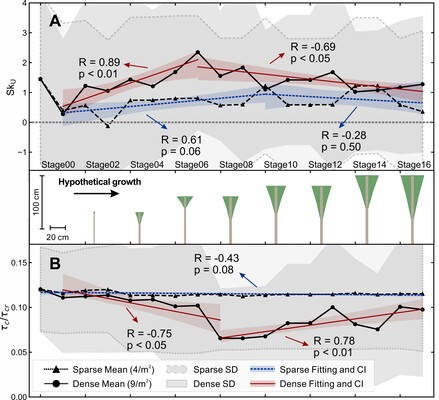J. Luo1, 2*, Z. Dai1 , J. H. Nienhuis2
1 State Key Laboratory of Estuarine and Coastal Research, East China Normal University, Shanghai, China; 2 Department of Physical Geography, Utrecht University, Utrecht, the Netherlands
* Corresponding author: jiejunluo@stu.ecnu.edu.cn; j.luo1@uu.nl
Introduction
Salt marshes and mangrove wetlands provide crucial ecosystem services to deltaic areas. They also significantly modulate hydrological conditions (e.g., currents, tides, and waves), thereby altering sediment dynamics and morphology. However, quantified comparison between these vegetation types and their effect on morphology remains a largely unresolved question.
Here we compare the hydro-morphodynamic development of a salt marsh versus a mangrove restoration site.
Objective and Methods
We have conducted fieldwork in the Changjiang (Yangtze) River Estuary (salt marshes) and in the Beibu Gulf (mangroves) in China. The fieldwork encompasses measurements of flow velocities, waves, tides, turbidity levels, sediment grain sizes, bed level changes, and vegetation characteristics. Additionally, the numerical model Delft3D is utilized to investigate the interactions between vegetation and hydro-sedimentary processes.
Results
Preliminary results from fieldwork reveal that both salt marshes and mangroves effectively attenuate waves and currents, promoting sediment deposition, particularly at the interface between bare flats and vegetated zones. In calm weather, salt marshes tend to accumulate sediment more readily than mangroves. However, during storm events, salt marshes are more susceptible to erosion, resulting in greater variability in sediment dynamics. There are also seasonal differences. In salt marshes, wave and current attenuation is more pronounced during summer than winter, whereas such seasonal variation is less significant in mangroves. Multi-year variability, on the other hand, may be greater in mangroves.
In ongoing numerical simulations, we find a strong nonlinear sedimentation effect as mangroves transition from small saplings to mature individuals (Figure 1). Future work will include modeling the role of salt marshes, with comparisons across different temporal scales (e.g., tidal cycles, seasons, years, and decades) and in direct competition with mangroves. Broadly, these findings will help us to explore potential river delta change as mangroves encroach on salt marshes in our warming planet.

Figure 1. Simulated progressive alteration of hypothetical vegetation morphological growth on hydrodynamics at the early growth stage within a restored estuarine pond. Impact of plant growth on (A) tidal asymmetry denoted by velocity skewness Sk_U; and (B) normalized bed shear stress \tau_c/\tau_{cd}. SD in the figure denotes standard deviation, and CI denotes confidence interval. Red blocks represent the dense planting scenarios and blue blocks represent the sparse planting scenarios. (Figure from Luo et al., in review.)
References
Luo, J., Dai, Z., Liang, X., Zeng, W., Wang, R., Huang, H., and Nienhuis, J. H. (in review). Hydro-sediment dynamics in an abandoned estuarine pond under artificial mangrove restoration. Submitted to Journal of Hydrology [Oct. 2024].


